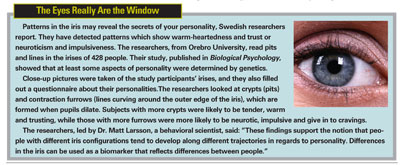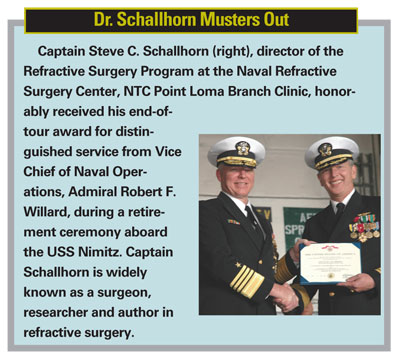Persons affected by glaucoma are more than three times as likely to have been involved in falls and motor vehicle accidents than persons of the same age without the condition, say researchers from
The study involved 48 patients 50 years of age or older with glaucoma and 47 age-matched persons without the eye disease. Glaucoma patients were almost three times as likely to have experienced one or more falls in the previous year and more than six times as likely to have been involved in one or more motor vehicle accidents in the previous five years. They were also more likely to have been at-fault for motor vehicle accidents in which they were involved. The strongest risk factor for these motor vehicle accidents was impaired useful field of view.
This research shows higher levels of falls and motor vehicle accidents than found in previous studies. These results have a potentially useful application in patient education, licensing of drivers, and intervention programs.
Based on these results, the group has started a larger prospective study to better understand why patients with glaucoma may be more likely to have falls and motor vehicle accidents, said researcher Sharon A. Haymes, PhD, of the Department of Ophthalmology and Visual Sciences at Dalhousie. "We need to find ways to help them minimize their risk," she says.

Genetic Testing Proving Useful in Some Eye Diseases
Genetic testing for eye disease is providing vital information about complex retinal diseases, especially when used to confirm a clinician's diagnosis. In a review of such tests that were conducted over a five-year period at the University of Michigan Kellogg Eye Center, scientists were able to confirm a clinician's diagnosis in half of the cases. The testing took place in the laboratory of Radha Ayyagari, PhD, director of Kellogg's Ophthalmic Molecular Diagnostic Laboratory.
In the February issue of Archives of Ophthalmology, Dr. Ayyagari and colleagues report on 350 genetic tests conducted since 1999, when the U-M Ophthalmic Molecular Diagnostic Laboratory became one of the first laboratories in the nation to receive government approval for ophthalmic testing under the Clinical Laboratory Improvement Amendment (CLIA). For each test described in the current study, scientists analyzed one or more of eight genes known to cause diseases of the retina.
Of the 350 tests, 266 were performed to confirm a clinician's diagnosis, by far the most common use of genetic testing for eye disease. Another 75 tests sought to determine whether an individual was a carrier of a disease, and nine tests were used to predict the likelihood that an individual with a family history of a given eye disease would go on to develop it.
Dr. Ayyagari's team was able to determine the molecular basis of the disease in half of 266 tests conducted to confirm a diagnosis. These results are significant because many retinal diseases present similar symptoms, and it is sometimes difficult for even the most skilled specialist to distinguish one from the other. By comparing a patient's DNA to known disease-causing genes, scientists deliver information needed to confirm or rule out a diagnosis. To date, scientists have identified more than 130 genes associated with retinal disease, such as retinitis pigmentosa and macular degeneration.
The authors observe that genetic testing for eye disease is a relatively new and evolving practice. Says Dr. Ayyagari, "Molecular diagnostics does not replace the necessary expertise of the ophthalmologist; rather, it adds a new tool to the ophthalmologist's diagnostic arsenal."
The report describes one case in which parents (with no family history of retinal degeneration) requested genetic testing in hopes of revealing the specific nature of their son's eye disease. They also wanted to know whether the younger son, who was experiencing more subtle symptoms, had the same disease or a milder vision problem due to a different disease. Testing revealed that both boys had two gene mutations linked to Stargardt's macular degeneration.
Genetic counseling is a crucial part of the genetic testing process, particularly when the patient may face the possibility of blindness, says Dr. Ayyagari. The family needs to prepare for all possible test results, understand the implications of these results for the patient and other family members, and be aware of the limitations of genetic testing. If physicians do not have the time or skills to provide this background, Dr. Ayyagari urges them to refer their patients to genetic counselors.
The study also reported that a diagnosis could not be confirmed in 133 cases, or half the tests conducted to confirm a diagnosis. "It is very difficult for patients to understand that the test may not be definitive," says Dr. Ayyagari. "Genetic testing may not always yield the firm facts we receive in other kinds of testing, such as blood tests for cholesterol levels."
A related point of confusion is that an inconclusive result does not necessarily rule out a diagnosis for a given disease. Limitations still exist in technologies for genetic testing, explains Dr. Ayyagari. In addition, very slight genetic variations believed to be benign may have either a cumulative effect or may alter the way another gene functions. Finally, while there has been great progress, scientists have yet to identify all the genes that contribute to diseases of the retina. "Tomorrow we may discover a new gene that explains many of the previously inconclusive test reports," says Dr. Ayyagari.

In a related paper in the same issue of Archives, Stephen Daiger, PhD, of the University of Texas Health Science Center, writes on the promise of genetic testing for eye disease. "Across all of the categories of inherited retinopathy, careful screening of known disease genes leads to detection of pathogenic mutations in 25 to 90 percent of patients, an extraordinary accomplishment," he notes.
It is to the patient's advantage to have a molecular diagnosis on file, observes Dr. Ayyagari. "When treatments begin to emerge for these complex genetic diseases," she says, "the individual's genotype may determine whether a new treatment will be the one that works for that patient."
Some Video Games May Sharpen Vision
Video games that contain high levels of action can actually improve vision, say researchers at the
"Action video game play changes the way our brains process visual information," says Daphne Bavelier, professor of brain and cognitive sciences at the university. "After just 30 hours, players showed a substantial increase in the spatial resolution of their vision, meaning they could see figures like those on an eye chart more clearly, even when other symbols crowded in."
Prof. Bavelier and graduate student Shawn Green tested college students who had played few, if any, video games in the last year. At the outset, the students were given a crowding test, which measured how well they could discern the orientation of a "T" within a crowd of other distracting symbols. Students were then divided into two groups. The experimental group played an action game for roughly an hour a day. The control group played a game equally demanding in terms of motor control, but visually less complex.
After about a month of near-daily gaming, the control players showed no improvement on the test, but the action-game players could tell which way the "T" was pointing much more easily than they had just a month earlier.
"When people play action games, they're changing the brain's pathway responsible for visual processing," says Prof. Bavelier. "These games push the human visual system to the limits and the brain adapts to it. That learning carries over into other activities and possibly everyday life."
The improvement was seen both in the part of the visual field where video game players typically play, but also in the part of vision beyond the monitor. The students' vision improved in the center and at the periphery where they had not been "trained." That suggests that people with visual deficits, such as amblyopic patients, may also be able to gain an increase in their visual acuity with special rehabilitation software that reproduces an action game's need to identify objects very quickly.
The team is now delving into how the brain responds to other visual stimuli using a new 360-degree, virtual-reality computer lab being completed at the university.



